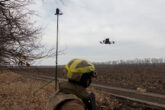March 11, 2022
How to Stop Putin Without Starting WWIII
Putin’s aggression must be stopped, but Washington is atwitter with dangerous ideas about how to do so, like establishing a no-fly zone over Ukraine, which would require shooting down Russian planes. The United States and other European countries must demonstrate a heavy cost to Putin’s invasion to deter future aggression, but without risking direct conflict. Putin has badly miscalculated and is already paying a heavy price for the invasion. The United States and NATO allies have two objectives at the moment: deterring future Russian aggression by demonstrating a heavy cost to this invasion; and avoiding direct conflict with Russia. During the Cold War, the United States resisted the Soviet Union in proxy conflicts around the globe without coming to direct blows. The same carefully calibrated response is needed to Russia’s invasion of Ukraine. The United States and other NATO countries should aid Ukraine through weapons, intelligence, and diplomatic support, but should stay clear of direct involvement in the war.
The United States and other NATO countries should aid Ukraine through weapons, intelligence, and diplomatic support, but should stay clear of direct involvement in the war.
Several ideas have recently been floated that risk implicating the United States and/or NATO in the conflict. The most dangerous of these is a no-fly zone, advocated by a number of former U.S. military and civilian government officials. Enforcing a no-fly zone would require U.S. and NATO warplanes to patrol over Ukrainian territory, well within range of Russian air defenses, and shoot down Russian aircraft that violate the no-fly zone. The United States would kill Russian pilots and would likely have to attack Russian air defenses, potentially on Russian soil. Russia would kill American pilots. A no-fly zone would put the United States and Russia at war with one another. There is no “limited” no-fly zone option, protecting humanitarian corridors or some other limited mission, that would avoid this stark reality.
Enforcing a no-fly zone would risk World War III and for little gain. The bulk of Russia’s offensive firepower comes from ground forces and surface-to-surface missiles, not airpower. In the unlikely event that the United States actually carried out a no-fly zone, it would do little to tilt the balance on the ground, potentially leading to further calls to expand U.S. air operations to include a “no-drive zone” in which U.S. warplanes attacked Russian ground forces.
Read the full article from Defense One.
More from CNAS
-
Defense / Transatlantic Security
When Defense Becomes Destruction: Austria-Hungary’s Mistake and Ukraine’s RiskThis article was originally posted on War on the Rocks. The southeastern Polish city of Przemyśl, with its elegant 19th century Habsburg-era train station, remains one of the ...
By Franz-Stefan Gady
-
Defense / Transatlantic Security
Ukraine’s Catch-22 MomentThis article was originally published in the Financial Times. In Joseph Heller’s wartime classic, Catch-22, the protagonist Yossarian seeks out the US army surgeon Doc Daneeka...
By Franz-Stefan Gady
-
CNAS Insights | Budgetary Own Goals Undermine “Speed and Volume”
On November 7, Secretary of Defense Pete Hegseth laid out a plan to overhaul the Department of Defense’s (DOD’s) acquisition system. Placing an emphasis on delivering new capa...
By Philip Sheers, Carlton Haelig & Stacie Pettyjohn
-
Drones: Who Is Making the New Weapons of War?
From Ukraine and Russia to Gaza and Sudan, drones have become a key weapon of war. Which companies are making them, and profiting from this rapidly expanding but controversial...
By Stacie Pettyjohn




